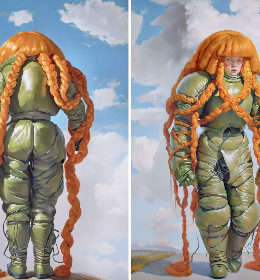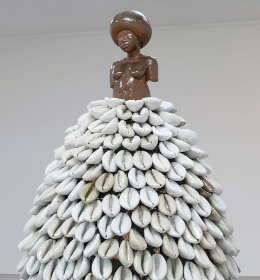To reduce the financial risk for participating galleries, you introduced a model based on profit-sharing, where galleries become shareholders and receive 35% of the profits generated by the fair, the amount being split between participants. How does your business model function to generate revenues? Beyond renting booths, ticket sales and sponsorships, do you foresee any other revenue streams?
RMF: The profit-sharing model came out of a curiosity to involve the galleries as investors in this business. We briefly considered giving the galleries equity in the business, but it was not realistic considering how many parties we are working with and in so many different countries. It was when I was discussing this concept with a collector friend, Jon Dodd, that he mentioned “Well what you are talking about sounds like profit-sharing.” In that moment a light bulb went off in my head: we didn’t have to give away ownership of the company, but just work with the galleries as informal investors who get rewarded each year.
We are a petite start-up, and our goal is to keep costs as low as possible for the exhibitors without skimping on the overall quality of the fair. For the first couple of years we want to focus on refining the fair and our messaging while we grow and develop our audience. During these formative years our revenue will be similar to how a traditional trade show operates: booth fees, ticket sales and sponsorships.
We are being very conservative with our budget out of respect for our gallery clients. The reward they get at the end of the year, while nominal, is a gesture of transparency so that our galleries understand how their investment is used. We know that the individual share may be very meaningful for a young dealer, yet may not be exciting for an established dealer who may also have a strong secondary market presence. Either way, they will have the option to take the cash or donate it to what we call a “Pay It Forward Fund,” in which the sum total of donated shares will be awarded to a young gallery the following year. What is exciting is that the fair is connecting with galleries of different levels, people are attracted to our values of community and transparency.
Regarding other revenue streams down the road, we are interested in empowering galleries and collectors. We spend a lot of time discussing what can be done to make art collecting more accessible. We also envision our principle of collaboration to extend beyond the galleries; our company is interested in working with other fairs, brands and institutions. There is so much we want to tap into but our focus right now is to be present in the moment. All eyes and efforts are on making the inaugural fair in May as exciting as it can be. When those other ideas become more than seeds and they are ready to have legs of their own - we’ll let you know!
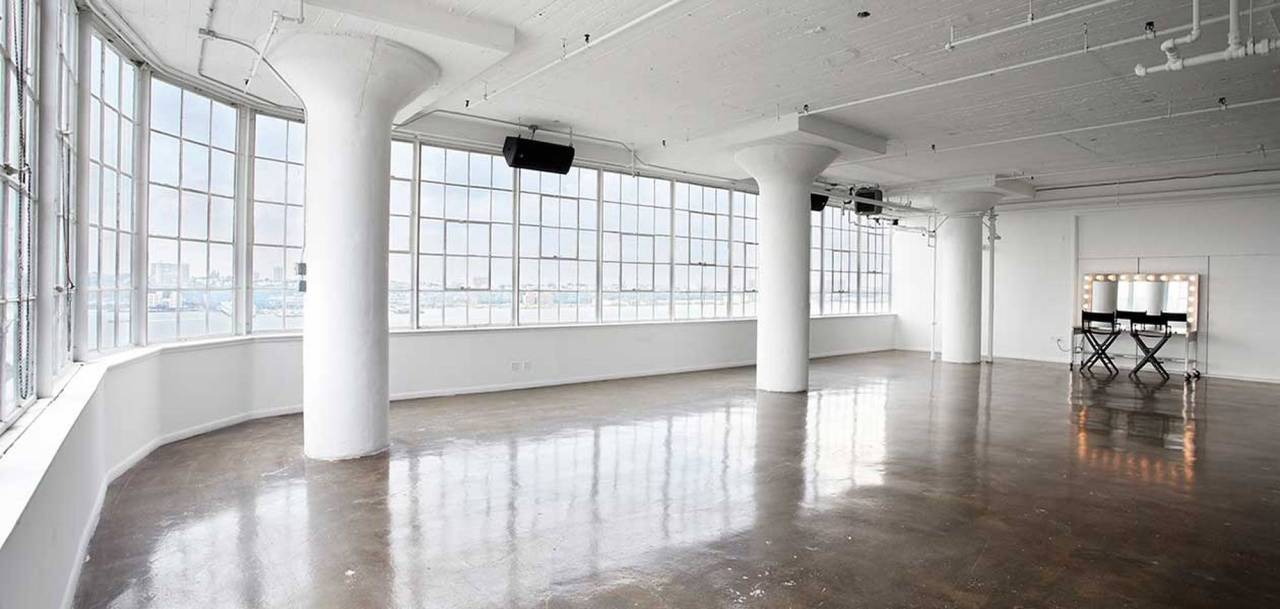
Canoe Studios Photo by Venky Photography Courtesy of Canoe Studios
Galleries participating in the first year become shareholders, and to further transparency you provide a budget report and a cost breakdown so they are aware of and understand how their share is invested. However, if a gallery does not wish to participate in the upcoming edition(s), do they still receive their share? What are the options? Did you foresee any withdrawal possibility?
RMF: The founding galleries are grandfathered into a profit-share with the company for the first 4 years of the business. That means any profits within those first 4 years made through the art fair or outside it will be shared with the galleries.
If a gallery is not able to participate after the first year, they will still receive their share throughout the 4 years and have the options to keep it or put it in the “Pay It Forward” fund.
While I do expect we will have a very high retention rate of exhibitors, I don’t think it’s fair to lock a gallery into a four year exhibitor contract. A lot can happen in four years, a gallery might close or change ownership. They might have a personal event that overlaps with the fair dates and need to skip a season. It’s fine with us if they are not able to return. The fair is so tight, it will open up some space for a new voice to join the community.
Galleries can opt for different room size, ranging from 300 to 700 square feet for a price range from $6,500 up to $10,900. Do galleries receive a different share depending on the amount spent in their booth?
RMF: No, it keeps things easy for everyone if we do an even split. In the grand scheme of things when the average price for an art fair stand is $30k, I don’t think it makes sense to be splitting hairs between a gallery paying $7000 to a gallery paying $10,000.
Eventually, you also propose communication and marketing services to galleries, beyond the unique context of the fair; those include editorial articles and a listing of their upcoming exhibitions published on your website. In this cooperative system, how would you define your role as a fair and also, what is your ultimate objective regarding exhibitors and their needs?
RMF: This is a great question. Our ultimate goal is to foster sustainability for galleries. We want to think outside of the box as to how galleries can strategize their growth and stay committed to their artists. Finally, we want to create a brand that is unpretentious and inspires people to love art, see it and buy it.
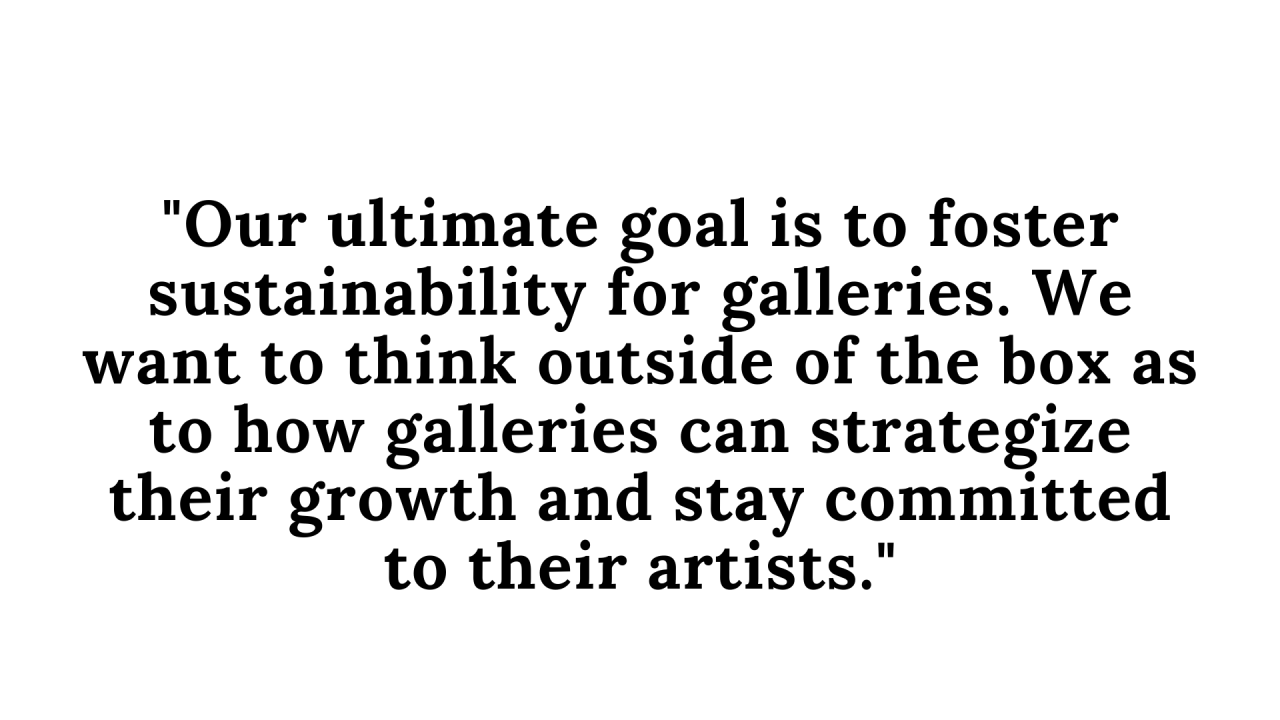

Could you explain what procedure galleries follow to apply and which criteria are taken into account for the selection? Do you have a committee? Are there already some names you could announce? Also what is the market range you focus on - from emerging to high-end?
RL: Together with our advisory board, we nominated a select list of galleries to receive an invitation to apply. They were chosen based on the quality of their year-round programs, the artists they represent and their previous art fair participation. From the start, we wanted to create a platform presenting a diverse level of galleries who work with a roster of artists who are also at varying points in their careers; we want contemporary art to be accessible to as diverse a group as possible. We want to honour the gallery eco-system by providing a platform that presents a true snapshot of the art industry today, from galleries run by seasoned dealers who have been in the game for decades, to respected mid-career galleries and artist-run spaces who are doing important work to bring emerging artists to wider audiences.
We spent the last 2-3 months having conversations with gallery directors in person or over the phone, to really get a sense of what their goals are and who they are as people. It’s important to us that what we are building resonates with our galleries, that they are excited by our mission, and also ultimately that our goals are in alignment. It’s in our best interest to build long-term relationships with these galleries, and it's been such an enjoyable experience having such a personal connection with these dealers, learning more about how they got into this business, how they work with their artists and where they see themselves over the next 3-4 years.
We are currently reviewing applications and will be finalising the list of inaugural galleries between now and mid-January. Many galleries were nominated by our Advisory Board and we are taking their recommendations very seriously and vetting galleries closely with them over the next few weeks. Many galleries will be working with artists who are making new work for the show so, for the purposes of the application, we are really looking to get a clear sense of their curatorial voice, an overall understanding of the aesthetic of the presentation and any overarching themes and narratives.
Our goal is to announce the final list of galleries early in January — but we can share that we are really thrilled by the developing personality and aesthetic of the show. There will be a strong pool of local, well-respected New York and US-based galleries and a diverse international presence. We are really honoured to be building this show with this growing community of dealers.
Galleries will operate in pairs in a room they co-curate. They can apply jointly or solo, and if so, you plan to assign a partner. By introducing those duos, you intend to further dialogue and communication among galleries. Do you think the discussions might also extend beyond duos? Do you foresee being involved in the curation yourself and being part of the dialogue between pairs? Beyond duos curating separate rooms, do you envision this process might lead to a more comprehensive curation and a global dialogue among galleries and possibly you?
RL: Yes, participating galleries are invited to apply with a gallery partner and a co-curated exhibition presentation in mind. Galleries can also apply solo, in which case we will partner them up with a gallery that makes sense curatorially, based on whether their artists share a similar aesthetic, voice or narrative.
While Future Fairs is the first to introduce co-curated booths as a requirement, we are seeing more and more galleries collaborating in this way already at fairs around the world. This level of collaboration among galleries, in its many forms, is helping dealers lower art fair participation risks by sharing costs, resources and collectors. It also offers the opportunity to contextualise their artists in new ways, allowing for deeper engagement that might otherwise be slightly lost in the traditional art fair context.
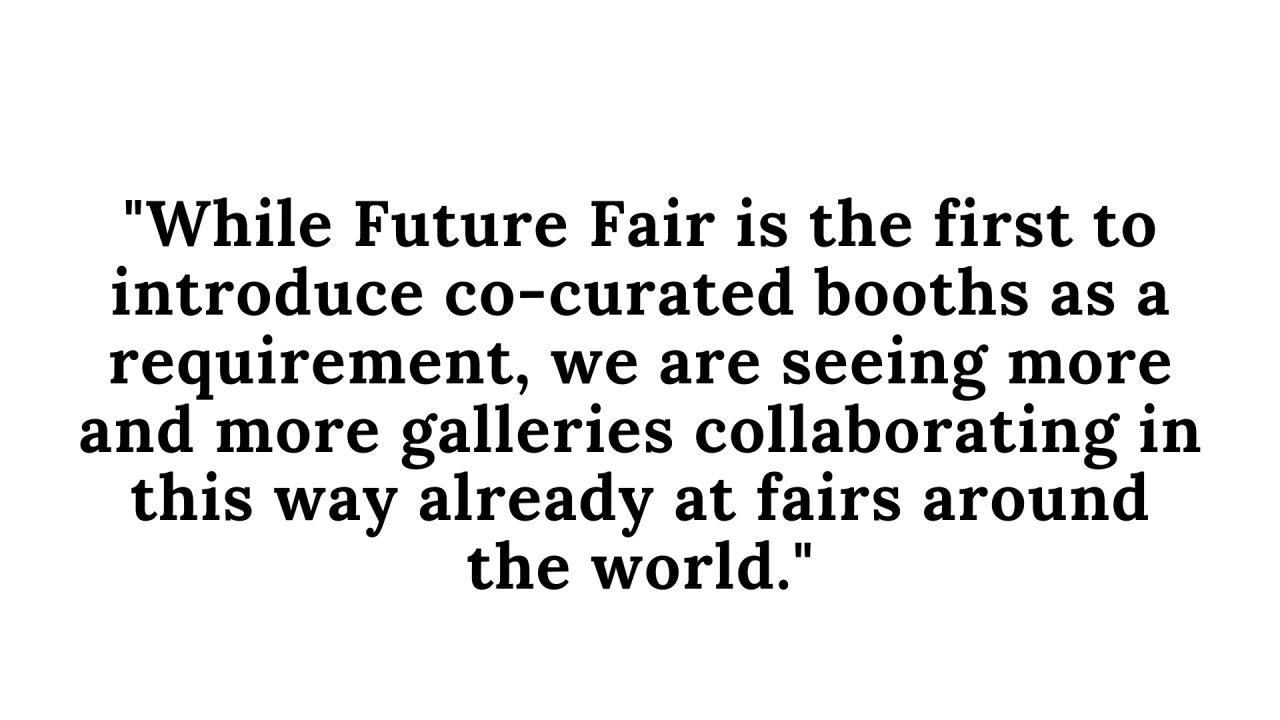
During our conversations with galleries and with many of our Advisory Board members who travel extensively to fairs around the world, we were excited to learn that our proposal had sparked conversations amongst gallery peers that may not have spoken about collaborating in this way previously. Dealers operating within the global art market often share artists, audiences, collectors and industry hacks and know-how! So we believe moving towards a more collaborative art market is really important, ultimately it helps build the careers of artists worldwide.
We selected galleries because we know and trust their curatorial skills and voices. While we will keep the dialogue open so that we can ensure we set our galleries up for success — i.e. we may recommend working with this or that artist in their roster if we believe they are particularly well suited to the current New York art market — it is ultimately up to the galleries to show what they are most excited about bringing to New York in May. We believe that energy ultimately emanates to collectors and visitors and will contribute to the overall success of the show.
You seem to put a great emphasis on content, with a wish to further discussions and communication among all stakeholders. How will the public be involved within this environment? What are you planning on the side to enrich your programme during and beyond the fair? How does this build on the overall experience you offer to the public and could you define what sort of experience you wish to offer them?
RL: We’re really interested in story-telling. We have a great deal of respect for the work gallery directors do and we want to help tell their stories, as well as the stories of their artists. We are working closely with our incredible design agency DoThings NYC to create short, bite-sized editorial pieces to help tell those stories, ensuring our audiences know about them before we even open our doors.
In terms of collateral event programming around the 3-day event, we will be working closely with our partners to create curated experiences and activations focused on the exhibitors and their artists i.e. artist talks, guided tours. We want to minimize distractions from wherever possible, and find ways to design an environment where visitors and collectors can come enjoy, engage and participate in meaningful ways.
You intend to shift perspectives by introducing Future Fairs. What is your insight on the current state of the art market, and also the role of fairs, the system in which they (inter)act? Do you envision an evolution of this system? Is there currently space for new models to establish in the long-term, and ultimately a possibility to durably influence the whole fair system?
RL: We have a great deal of respect for the teams behind art fairs big and small, and we couldn’t be doing what we are doing if they hadn’t laid the groundwork for us. We believe fairs are hugely important platforms for art commerce, and also meeting points for the global art community; where galleries, artists, collectors and art lovers of all kinds, convene and make important connections. We simply want to create optionality that honours the diversity of how the industry operates, and see if there are ways we can design more sustainable models for an increasingly competitive landscape.
RMF: No matter the industry, there is always space for innovation. For us, we spend a lot of time researching start-ups outside of the art world and considering how their blue-prints could be brought into this industry. Art is a creative industry, there is certainly space for creativity in the business of art.
As our industry evolves, I do believe that we will become more collaborative. I envision that small fairs like ourselves will align with other independently run shows. We are already seeing galleries collaborate on exhibitions and share spaces -- this is going to become more common. I also believe that this is a generational shift, it is something that we see younger galleries who are of our generation already doing. It is all very exciting to think about what may come next!
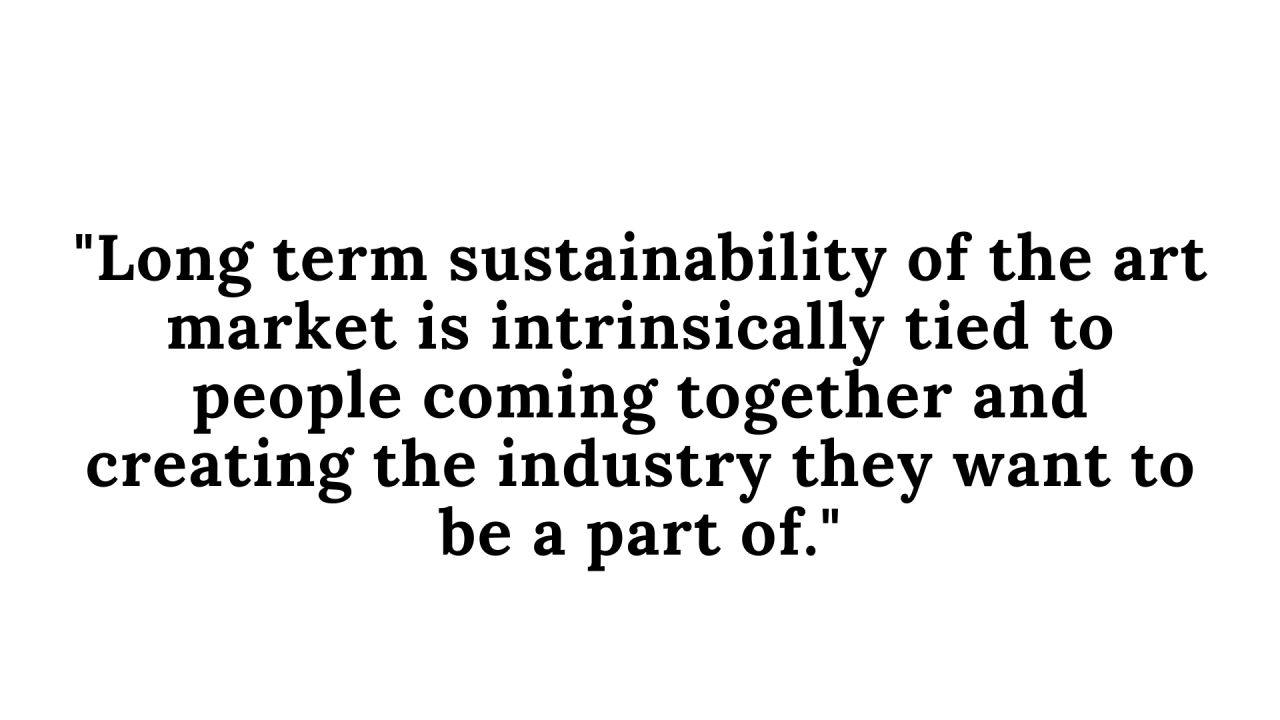
Rachel Mijares Fick possesses 9 years of art fair management experience at Volta, Frieze, and MCH Group. Rebeca Laliberte is art advisor, co-founder of Art Browsers and former gallery director at Beers London. The New York-based Future Fairs will launch its inaugural edition from May 7 to 9, 2020, in Canoe Studios, on the boundary of Chelsea and the new Hudson Yards district, and expect to welcome up to 36 exhibitors in the industrial lofts. The list of founding galleries is to be announced mid-January at the latest.








